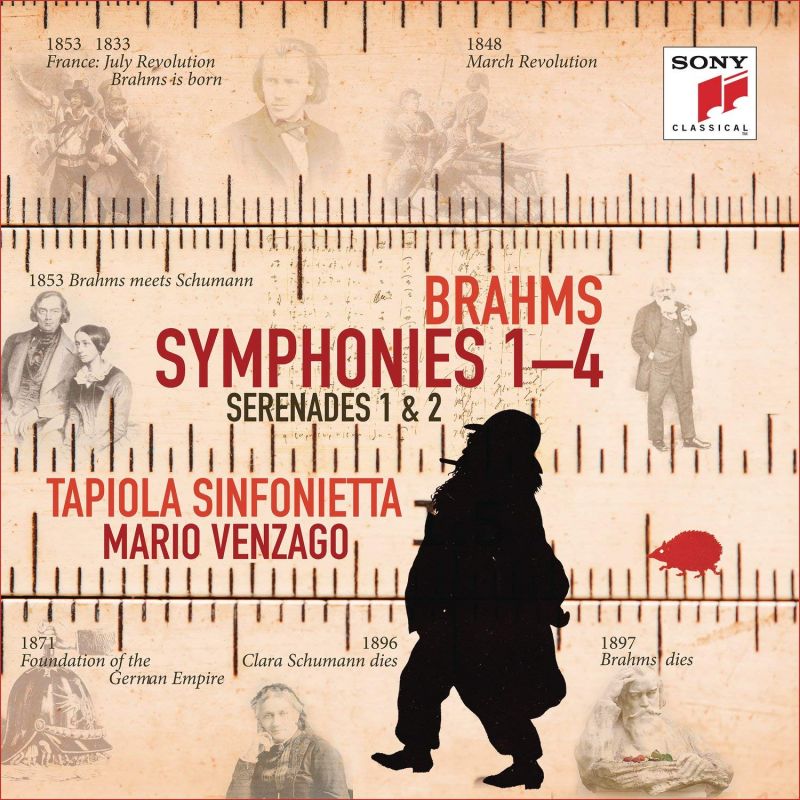BRAHMS Symphonies and Serenades (Venzago)
View record and artist detailsRecord and Artist Details
Composer or Director: Johannes Brahms
Genre:
Orchestral
Label: Sony Classical
Magazine Review Date: 10/2018
Media Format: CD or Download
Media Runtime: 221
Mastering:
DDD
Catalogue Number: 19075853112

Tracks:
| Composition | Artist Credit |
|---|---|
| Symphony No. 2 |
Johannes Brahms, Composer
Johannes Brahms, Composer Mario Venzago, Conductor Tapiola Sinfonietta |
| Serenade No. 1 |
Johannes Brahms, Composer
Johannes Brahms, Composer Mario Venzago, Conductor Tapiola Sinfonietta |
| Symphony No. 1 |
Johannes Brahms, Composer
Johannes Brahms, Composer Mario Venzago, Conductor Tapiola Sinfonietta |
| Serenade No. 2 |
Johannes Brahms, Composer
Johannes Brahms, Composer Mario Venzago, Conductor Tapiola Sinfonietta |
| Symphony No. 3 |
Johannes Brahms, Composer
Johannes Brahms, Composer Mario Venzago, Conductor Tapiola Sinfonietta |
| Symphony No. 4 |
Johannes Brahms, Composer
Johannes Brahms, Composer Mario Venzago, Conductor Tapiola Sinfonietta |
Author: Andrew Farach-Colton
Setting these recordings’ disparate interpretative perspectives aside, I believe it’s safe to assert that their common goal in employing a reduced string section is textural clarity – or, as Venzago puts it in his explanatory booklet note, ‘a focus on woodwind’. Strange, then, that his accounts are not notable for their lucidity. Even in the D major Serenade, a work squarely in the purview of a chamber orchestra, the winds often get swamped even by this smallish sea of strings. Whether this is the fault of the conductor or the engineers, I can’t say. I’ll wager, however, that the violins’ glassy sound is an engineering issue and unrelated to their sparing use of vibrato. Indeed, the Tapiola Sinfonietta play with impressive unanimity and conviction for Venzago, whose direction demands suppleness as much as precision.
Those put off by some unusual tempos in this conductor’s Bruckner cycle will find nothing so outlandish here. Even when Venzago sets a brisk pace, as in that First Serenade’s Adagio non troppo or the Second Symphony’s Allegretto grazioso, he allows the phrases room to breathe so there’s no feeling of undue haste. It’s in music that requires tautness and drive that these readings tend to fall short, so the inner movements are generally the most persuasive. All four slow movements are absolutely ravishing, in fact, each evoking an individual world of character and colour, from the First’s lyrical abandon to the Fourth’s elegiac solemnity. The Poco allegretto of the Third is drenched in melancholy – listen to the way the cello’s opening melody captures the very essence of that elusive mezza voce marking, and the halting phrases when the violins take the tune near the end, as if they can’t bear to let go of it. I’m also delighted by the way Venzago jiggles the accents in the Allegro giocoso of the Fourth so its rhythms practically froth.
The most successful overall performances are of the Second and Fourth symphonies and the First Serenade. I wish Venzago was less subdued in the Second’s finale – all those manic forte explosions are underplayed – although he does finally let loose in the coda, so it ends satisfyingly, at least. The opening Allegro non troppo of the Fourth is astonishingly delicate; I’ve never heard anything like it and, a few distractingly lurching tempo changes aside, its eloquence took me by surprise.
So where does that leave us in terms of Meiningen-style Brahms? Ticciati too often gets lost in his pursuit of detail; Mackerras’s flexible approach to tempo (borrowed from markings by the composer’s friend, Fritz Steinbach) can feel contrived; and Dausgaard’s series, while largely impressive thus far, remains incomplete (BIS, 4/13, 2/18, and above). That leaves Berglund, who illuminates without casting any distracting shadows or glare. Actually his is one of but a few wholly recommendable cycles, and that’s saying something. I’ll be hanging on to Venzago’s set, however, not so much for entire works but for when I want to luxuriate in one of the exquisitely played middle movements.
Discover the world's largest classical music catalogue with Presto Music.

Gramophone Digital Club
- Digital Edition
- Digital Archive
- Reviews Database
- Full website access
From £8.75 / month
Subscribe
Gramophone Full Club
- Print Edition
- Digital Edition
- Digital Archive
- Reviews Database
- Full website access
From £11.00 / month
Subscribe
If you are a library, university or other organisation that would be interested in an institutional subscription to Gramophone please click here for further information.




